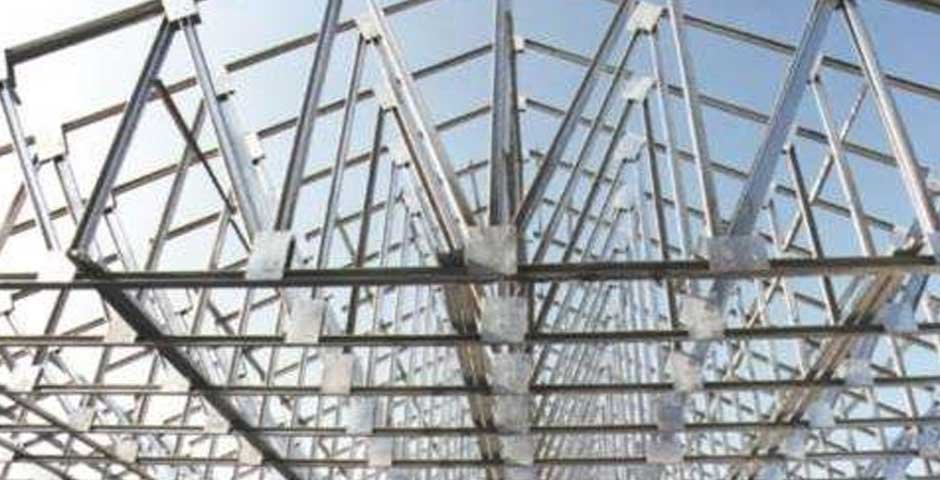Whether you’re building a bridge for a creek on your property, a mezzanine porch, or a flat-roof storage facility, you need to ensure that the top surface is properly supported to prevent accidents or damage to either occupants or building. This is why it’s necessary to utilize trusses that are specially designed for flat applications rather than pitched roofs or other angled structures, and bar joist trusses are your best bet. Today, we’ll explain what a bar joist truss is, how it works, and why you should consider this option for your next construction project.
The bar joist truss provides stability without sacrificing space or style
Bar joist trusses are typically found in commercial and industrial construction; They are always made of metal, typically steel, as they need to handle heavy loads without bending or splintering. Like other trusses, a bar joist consists of two parallel bars, or “chords,” with diagonal bars between that make a triangular pattern, or “web.” The internal component, the web, is made of a single bar of metal which is bent back and forth, then welded to the two chords on its top and bottom. These trusses can span quite long distances, up to 150 feet, between braces, and they will be made to order depending on the span that you need to cover.
This form of truss is almost always used to support a flat surface, either a roof or a floor, by distributing the weight from the roof or floor to the rest of the structure, usually the beams and columns connected to the trusses.
Bar joist trusses differ from gable roof trusses in both application and function
If you’ve built a pitched roof building before, you might look at a bar joist trust and imagine that it’s essentially the same as those that you used on your first project. Though they do look very similar, bar joist trusses and gable roof trusses aren’t used in the same way, nor do they function exactly alike.
Bar joist trusses are used for flat surfaces, while gable roof trusses are generally used for pitched roofs, hence the name “gable.” Because they help to support different structures, they also work differently.
To understand how these two trusses work, it’s important to consider the types of structures they support. Bar joist trusses are used with flat roofs, which means that the building they’re supporting is essentially a large box. As the roof gets further away from the walls, it doesn’t have the same support as the corners, and it would be easy for it to start to sag and crumble; hence, the bar joist trusses hold it in place and transfer the weight down to the beams located perpendicularly to the roof. This creates numerous points where the roof can be supported, which helps to ensure that no one part of the roof is carrying too much strain.
In contrast, gable roof trusses are used in buildings with a pitched roof: a triangle which is set atop four straight walls. In this circumstance, the trusses distribute the weight of the roof down to the walls, spreading the strain out amongst those four points of contact. While gable roof trusses may still use support beams and columns depending on its size, it is mostly transferring the weight outward from the center rather than downward onto support beams.
Trusses protect your roof from costly repairs – and can prevent a major accident
One may imagine that the walls of any building are strong enough to support the roof, but this isn’t necessarily true. Depending on how large a building is, the center of the roof may be too far away from the walls to rely upon them, and it will need support in order to prevent major accidents. However, placing a support beam directly against the roof won’t work either: there will suddenly be a lot of pressure pushing down on this one single spot, and it could lead to further damage to the roof. Either of these problems will necessitate expensive roof repairs.
This is where trusses come in. Because they distribute the weight of the roof down to the support beams, they act as an intermediary between these two essential parts of the building, making sure that the entire structure is safe and secure. An unsupported roof can easily start to crumble, which can either result in costly repairs or serious damage to the entire structure, and this is even more likely in large, flat-roofed buildings. By installing bar joist trusses during construction, you will reduce the load on the roof so that it can serve as a protective barrier between the rest of the structure and the outside elements.
Roof collapses, while relatively uncommon, can be expensive and deadly, causing thousands of dollars in damage to product or machinery – and even potentially taking a life. Bar joist trusses help to prevent this while also extending the life of your roof and ensuring that the entire structure remains secure.
Now that you better understand the function and value of bar joist trusses, be sure to contact a qualified and reputable truss manufacturer for your next product, and enjoy the many benefits of a well-supported roof.






